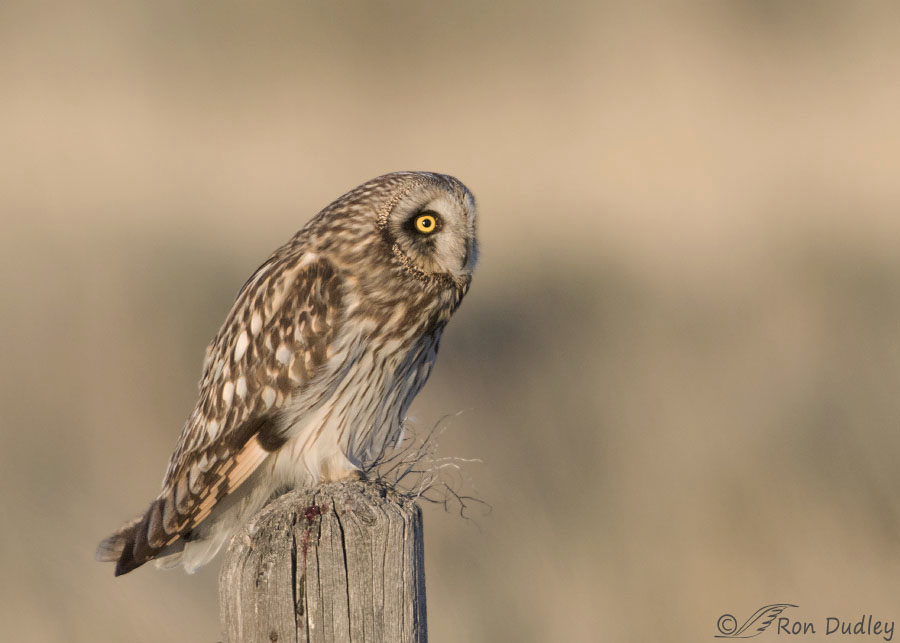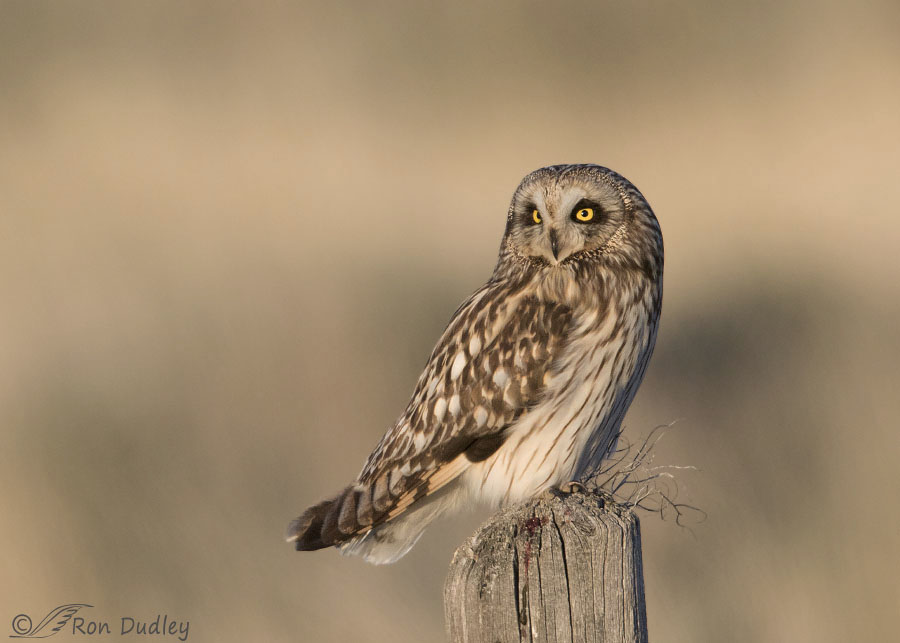And some speculation about the preferred perches of SEO’s.

1/2000, f/6.3, ISO 1000, Canon 7D Mark II, Canon EF 500mm f/4L IS II USM + EF 1.4 III Extender, not baited, set up or called in
Two days ago I had only my second close encounter with a Short-eared Owl of the season here in northern Utah. It was my first bird of the morning so I photographed it only minutes after dawn. I wanted takeoff and flight shots (none of them turned out well) so I adjusted my settings accordingly in the low light. This slightly hunkered-down pose was the owl’s reaction to a passing vehicle which made the bird a little nervous but it didn’t take off as the vehicle passed.
I don’t know the source of the vegetation on the fence post. It may have already been on the post when the owl landed there or it might have been stuck to the bird (or carried by it, which seems less likely but definitely possible) when it landed. I missed the takeoff shots so I can only guess but when it landed on another post about a minute later the sprig of dried vegetation wasn’t there.

1/2500, f/6.3, ISO 1000, Canon 7D Mark II, Canon EF 500mm f/4L IS II USM + EF 1.4 III Extender, not baited, set up or called in
The owl didn’t give me a lot of pose variety. I used to prefer owls looking directly at the viewer to highlight their big round, colorful eyes but over time my tastes have evolved so I chose to post this photo with the owl looking past me to my left. I think the blood on the old fence post adds interest because its origin was almost certainly raptor prey – perhaps from a vole captured by a Red-tailed Hawk or Swainson’s Hawk that are both common in the area. But it may also have been from prey of this very owl.
Readers know I nearly always prefer natural perches but if their perch of choice is man-made I can certainly live with rustic old wooden fence posts like this one. Besides, in areas I shoot at least, this species seldom perches on any elevated perches other than fence posts and I’ve often speculated as to why that’s the case. Other raptors in the area land on a variety of perches including power poles, trees, buildings and other vertical structures.
In many years of photographing SEO’s in Utah, Montana and Idaho I’ve only seen one on a power pole a single time and I don’t recall ever seeing one in a tree or on a building – they always seem to perch on fence posts (one time it was a fence wire), the ground or very low vegetation like sagebrush or rabbitbrush. They hunt primarily on the wing (rather than from perches like Red-tailed Hawks often do) but occasionally I’ve documented them actually hunting from fence posts. They even sleep and roost primarily on the ground although they will tree-roost in winter when there’s snow on the ground.
I can only guess why their perches of choice are so low to the ground. Perhaps it’s because they feel vulnerable to larger raptors or even mobbing corvids while they’re on elevated perches…?
Any thoughts on the subject from readers?
Ron
PS – I should mention a specific SEO that I observed perched high on a wire between power poles several mornings in a row – something I haven’t seen before or since.


Wonderful Ron!
Charlotte
Late again, but I’d suggest the reason is not one single element. Another factor could be that they’re closer to the voles who can disappear in a heartbeat. Just a thought.
Love that warm light, which I suspect was much warmer than the temperature.
Love the SEO.
And suspect as others have said, that their preference for low-lying perches relates to their position mid-way on the pecking order.
You’re right about that, EC. It was exactly 27 degrees F when I took these photos. I looked only moments before.
Ron
Interesting behavioral observations. They remind me of some of the behavioral traits of small wildcats (and outdoor house cats). Being both a predator and potentially prey, makes them behave differently from apex predators. Fascinating stuff. Oh and the photos are nice too😝
“Being both a predator and potentially prey, makes them behave differently from apex predators”
That’s a very interesting observation, Porcupine. I’d never thought about it in exactly that way but I think you may be right.
Great images Ron. I don’t know if one can make an analogy between what we see here in the east and your observations out west.
We live in an area where there are mountains and a lot of farmland. The Short-ears I see from time to time are either very low to the ground or on fence posts like what you have. I have only seen once an owl on a man-made sign. However, I do see, when there are many crows in an area, the owls are either out of sight or in thick grass. The only reason I know this is because I watched a flock of crows patrolling a field and after they passed, a Short-eared Owl flew out from a clump of thick grass. Surprised the heck out of me. Since that time I have become more aware of this species. So, from my perspective I think you are correct.
Thanks for that feedback, Dick.
Beautiful shots of one of my choice birds…the eyes have it with this bird. We have the ShortEars here in NE Wisconsin, primarily in marshes or grasslands. I’ve seen them on wooden posts, signs in the wetlands, amongst the grasses and I’ve photographed a few in small trees…understory types that are standing alone in the open. Northern Harriers and RoughLegged Hawks seem to love to attack them…diving at them and chasing them from their perch. Last evening I sat for 3 hours observing them and the hawks were relentless. The owls finally retreated to the taller grasses until they left and emerged to do their own hunting. Have to love the ‘yiping or barking’ type of call the owls give when flying at each other. One of Nature’s great joys!
You’re lucky Kathy, I haven’t heard that call very often.
Hi Kathy,
Are the SEOs mating in your county of WI?
Love everything about the second shot…the pose, the light, the old weathered wood post, the absndoned nesting material, the feather detail, the light and the composition….all of it!!
Thanks very much, Patty.
The facial disc edges seem especially striking on this Shortie. I keep going back to them again and again. The warm light is perfect on this gorgeous bird!
“The warm light is perfect on this gorgeous bird!”
That’s why I get up so damned early to get there in time, Marty! The light so very often makes the shot. Thank you.
And those of us who are still asleep at that time are very appreciative! 🙂
Beautiful photos Ron. They are such photogenic owls and you always do a great job photographing them.
When I see them, not nearly as much as you do, they are on posts, metal signs on refuges, or on the ground. I have never seen one up high on a telephone post. I think they stay low to the ground for cover, not to stand out and be attacked by hawks (Rough-legged hawks that like to be on taller posts it seems) or eagles.
I have noticed SEOW’s that have a favorite perch, and in those cases they were refuge signs about 6 feet off the ground, or on road signs. Perching on a cold, sharp edged, metal sign, or tee-post looks uncomfortable, but they do not seem to mind 😉
My observations are similar, Ed – though I rarely see them on signs. You may be right about the reason for their preference to stay low to the ground.
That 2nd owl picture is so gorgeous! A perfect shot. Bravo.
And thanks for all your info on owls. They are fascinating and beautiful.
That second one is my favorite too, Thanks, Joanne.
Beautiful photo Ron, and a very attractive owl. Can’t add anything to the Short Eared discussion since I have never seen one, and don’t think we have them here. Good weekend wishes for all, and Laura, thanks for the wear gloves warning. I’m sure that those experience people I will be with will have that in mind.
Everett Sanborn, Prescott AZ
Thank you, Everett.
FYI re this owls? https://www.owlpages.com/owls/species.php?s=3590.
I’m not seeing anything in the link about their apparent avoidance of elevated perches…?
Yes, I think it’s only implicit in that their predators are large buteos, and presumably it follows they’d need to get down fast…
Nice! The SEO’s we see here are mainly over the field and flying low making the fence post the “right” spot to observe perch perhaps?
Perhaps, Judy. But since other raptors take advantage of the high vantage point of elevated perches for hunting and other reasons I still have to wonder why SEO’s so rarely do. Just another thing to speculate about… 🙂
The vegetation was interesting. I wonder if it was part of a missed breakfast. 😀
It could have been, Arwen. As you know raptors often snag vegetation in their talons when the capture prey.